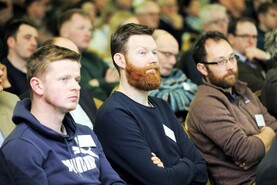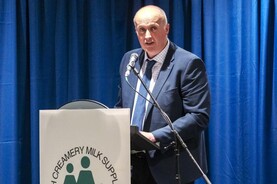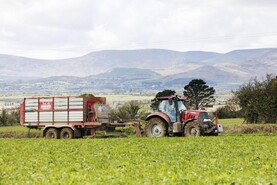Dara Killeen is farming in Co Galway in partnership with his father Charlie. The Killeens have been running beef and sheep enterprises on their farm for generations but are now in the process of converting to dairy farming entirely. The main reason they decided to go down the dairy road is because they wanted to be able to generate a decent second income. Dara always had an interest in the farm and farming. He spent six months in Invercargill, New Zealand, working on a dairy farm and for silage contractors in 2009. “I liked milking cows in New Zealand. The scale was phenomenal but there were things out there I didn’t like too,” he explained.
The building work is very satisfying to watch, but it can be stressful ... The phone is going the whole time, and you need to make decisions on a daily basis
When he got back home he did the Green Cert in Gurteen College, where he got some broad agricultural training. He worked at home on the farm and also milked cows for local dairy farmers. Between 2012 and 2017 he doubled sheep numbers from 250 to 500 mule ewes. He also started rearing Friesian bull calves as a new venture on top of the traditional beef enterprise of finishing continental-bred bullocks. The Killeens have been finishing 100 head of cattle per year in recent times.
Despite the scale of their drystock enterprises, the father and son team realised that it was extremely difficult to make a living without direct payments. “The realisation really set in after we did profit monitors through the knowledge transfer scheme,” Dara explained. That’s when they decided to look at dairying seriously. The Killeens have 45ha around the farmyard and a further 50ha of out blocks (some marginal).

He will use steel posts with plastic covering as intermediate posts for the paddock fencing.
“The idea of converting always cropped up because of the land base we have here but in the past we said it would cost too much to get in,” he said. However, Dara wanted to farm full-time and make a steady living without being dependent on direct payments. Dairy was the obvious move. Having the full support of his father and mother Mary was also a great boost to Dara to make the move.“We got in contact with Teagasc adviser Patrick Gowing from the dairy expansion service and he helped us draw up a plan,” said Dara.
They started doing their research during the spring and summer of 2017. During that time, Dara visited a number of dairy farms to get ideas and make sure he was putting the right plan in place. He said it was not difficult to deal with the banks because they had a strong business plan and quality dairy stock already bought. In the end it was down to two banks who were willing to deal with them and after some bargaining, an agreement was struck. In terms of time, Dara said it didn’t take that long to source the funds. “We approached the banks in October-November 2017 and we were able to start drawing down the money in May this year.”
In September 2017, the Killeens bought 60 high-EBI jersey cross weanlings (2017 spring-born calves) and bought a further 40 later in the autumn. “It worked out that two dairy weanlings cost the equivalent of one finished bullock which was a big help to build up the new dairy herd,” Dara explained. He bought 40 more weanlings this year. To source good stock he uses word of mouth and he has started using Twitter too, which worked really well for him this year.

Dara is building a new 20-unit herringbone parlour and handling area. He also plans to convert an existing sheep shed to cubicles.
Infrastructure
Dara is very keen to have an easily run dairy farm by the time conversion work is complete. As a member of the local dairy discussion group, he made use of the other members to establish what investments were critical for the new venture. Good grass production was pointed out as a vital component if he wanted to produce milk at a low cost. They reseeded over 50 acres this year so that they could hit the ground running with ample grass supplies next year for milking cows. Abergain and Aberchoice were the grass varieties of choice. There is no point growing a lot of grass if you can’t utilise it.
Patrick Gowing helped design a paddock and roadway system for the farm and Grasstec mapped the land showing exact paddock size, which will come in handy when measuring grass. In total, 1.5km of roadways were installed at 5m wide. A 150ft deep water well had to be drilled too. Terra Services installed a new water system using 40mm piping and 300 gallon concrete water troughs. The fencing is the last part of the field infrastructure work left to complete this year. Dara is using a novel idea for intermediate posts. Instead of timber stakes he will use steel rods with plastic covering and the fence line will be cable tied to these rods.

In total 1.5km of roadways were installed at 5m wide
“I am happy with it so far. If the cable ties break it won’t cost much to replace them,” he explained.
The other essential element of the conversion is the dairy parlour. It represents the biggest cost and will be the place where Dara will spend a lot of his time on the farm in the future. “We decided on a 20-unit herringbone parlour with room for 24 and a handling unit,” said Dara.
They settled on a DeLaval machine with the decision based on price and service availability in the locality. They are going to install a large bulk milk tank so they can avail of the Aurivo bonus for three-day collections. They will also have automatic cluster removers and an auto-wash system. The parlour is being built beside the sheep shed which will be converted to a cubicle shed next year. Aidan Kelly from Agri Designs and Planning Services designed the parlour, collecting yard and cubicle shed layout. A large 9ft deep slurry tank will be located at the end of the collecting yard and this will also be available to collect the slurry from the newly converted cubicle shed.

Heifers will graze this fodder crop to reduce the pressure on winter feed.
Project management
One of the biggest challenges so far in the conversion is project management, Dara feels. Building work on the new parlour is in full swing now and needs to be ready before cows start calving towards the end of January 2019. “The phone is going the whole time, and you need to make decisions on a daily basis,” he explained.
A conversion of this scale takes lots of management and planning. There is a lot of work involved in organising planning permission, a TAMS II application, organising builders and contractors, managing money and all the while making sure key deadlines are being met.
“The building work is very satisfying to watch, but it can be stressful,” Dara warned. He got every job priced before the first sod was turned. The only expenditure that was not priced in advance was the roadway. This job was carried out on a per-hour basis, which made budgeting slightly trickier. Dara keeps a close eye on what is being spent and cross references it with what was planned.
Every time he needs to pay for work carried out he has to show invoices to the bank first. This can be burdensome at times but it does force him to watch spending closely. The availability of a big pot to spend from freely could be risky.
Advice
Despite the stress involved with the conversion work, Dara still has his eyes on the prize and it is within reach. This time next year, all going well, he should be milking cows and have the majority of the building work complete. “We agreed to become the Aurivo farm programme new entrant focus farm 2018 to 2020, which has been a real help taking advice from experts and talking to other new entrants” said Dara.
For other aspiring new entrants, Dara offered the following advice:
Go to plenty of farm walks and visit other farms to figure out the type of system you want on your farm.Once you pick a system, stick with it.Get in touch with good farmers with that system in place and try to find a mentor.Get involved with discussion groups.Buy the best stock possible.Have your figures done and draw up a business plan.Stick with the plan.Draw up a timeline and make sure your ducks are in a row i.e bank, ESB connection, builders etc.
Dara Killeen is farming in Co Galway in partnership with his father Charlie. The Killeens have been running beef and sheep enterprises on their farm for generations but are now in the process of converting to dairy farming entirely. The main reason they decided to go down the dairy road is because they wanted to be able to generate a decent second income. Dara always had an interest in the farm and farming. He spent six months in Invercargill, New Zealand, working on a dairy farm and for silage contractors in 2009. “I liked milking cows in New Zealand. The scale was phenomenal but there were things out there I didn’t like too,” he explained.
The building work is very satisfying to watch, but it can be stressful ... The phone is going the whole time, and you need to make decisions on a daily basis
When he got back home he did the Green Cert in Gurteen College, where he got some broad agricultural training. He worked at home on the farm and also milked cows for local dairy farmers. Between 2012 and 2017 he doubled sheep numbers from 250 to 500 mule ewes. He also started rearing Friesian bull calves as a new venture on top of the traditional beef enterprise of finishing continental-bred bullocks. The Killeens have been finishing 100 head of cattle per year in recent times.
Despite the scale of their drystock enterprises, the father and son team realised that it was extremely difficult to make a living without direct payments. “The realisation really set in after we did profit monitors through the knowledge transfer scheme,” Dara explained. That’s when they decided to look at dairying seriously. The Killeens have 45ha around the farmyard and a further 50ha of out blocks (some marginal).

He will use steel posts with plastic covering as intermediate posts for the paddock fencing.
“The idea of converting always cropped up because of the land base we have here but in the past we said it would cost too much to get in,” he said. However, Dara wanted to farm full-time and make a steady living without being dependent on direct payments. Dairy was the obvious move. Having the full support of his father and mother Mary was also a great boost to Dara to make the move.“We got in contact with Teagasc adviser Patrick Gowing from the dairy expansion service and he helped us draw up a plan,” said Dara.
They started doing their research during the spring and summer of 2017. During that time, Dara visited a number of dairy farms to get ideas and make sure he was putting the right plan in place. He said it was not difficult to deal with the banks because they had a strong business plan and quality dairy stock already bought. In the end it was down to two banks who were willing to deal with them and after some bargaining, an agreement was struck. In terms of time, Dara said it didn’t take that long to source the funds. “We approached the banks in October-November 2017 and we were able to start drawing down the money in May this year.”
In September 2017, the Killeens bought 60 high-EBI jersey cross weanlings (2017 spring-born calves) and bought a further 40 later in the autumn. “It worked out that two dairy weanlings cost the equivalent of one finished bullock which was a big help to build up the new dairy herd,” Dara explained. He bought 40 more weanlings this year. To source good stock he uses word of mouth and he has started using Twitter too, which worked really well for him this year.

Dara is building a new 20-unit herringbone parlour and handling area. He also plans to convert an existing sheep shed to cubicles.
Infrastructure
Dara is very keen to have an easily run dairy farm by the time conversion work is complete. As a member of the local dairy discussion group, he made use of the other members to establish what investments were critical for the new venture. Good grass production was pointed out as a vital component if he wanted to produce milk at a low cost. They reseeded over 50 acres this year so that they could hit the ground running with ample grass supplies next year for milking cows. Abergain and Aberchoice were the grass varieties of choice. There is no point growing a lot of grass if you can’t utilise it.
Patrick Gowing helped design a paddock and roadway system for the farm and Grasstec mapped the land showing exact paddock size, which will come in handy when measuring grass. In total, 1.5km of roadways were installed at 5m wide. A 150ft deep water well had to be drilled too. Terra Services installed a new water system using 40mm piping and 300 gallon concrete water troughs. The fencing is the last part of the field infrastructure work left to complete this year. Dara is using a novel idea for intermediate posts. Instead of timber stakes he will use steel rods with plastic covering and the fence line will be cable tied to these rods.

In total 1.5km of roadways were installed at 5m wide
“I am happy with it so far. If the cable ties break it won’t cost much to replace them,” he explained.
The other essential element of the conversion is the dairy parlour. It represents the biggest cost and will be the place where Dara will spend a lot of his time on the farm in the future. “We decided on a 20-unit herringbone parlour with room for 24 and a handling unit,” said Dara.
They settled on a DeLaval machine with the decision based on price and service availability in the locality. They are going to install a large bulk milk tank so they can avail of the Aurivo bonus for three-day collections. They will also have automatic cluster removers and an auto-wash system. The parlour is being built beside the sheep shed which will be converted to a cubicle shed next year. Aidan Kelly from Agri Designs and Planning Services designed the parlour, collecting yard and cubicle shed layout. A large 9ft deep slurry tank will be located at the end of the collecting yard and this will also be available to collect the slurry from the newly converted cubicle shed.

Heifers will graze this fodder crop to reduce the pressure on winter feed.
Project management
One of the biggest challenges so far in the conversion is project management, Dara feels. Building work on the new parlour is in full swing now and needs to be ready before cows start calving towards the end of January 2019. “The phone is going the whole time, and you need to make decisions on a daily basis,” he explained.
A conversion of this scale takes lots of management and planning. There is a lot of work involved in organising planning permission, a TAMS II application, organising builders and contractors, managing money and all the while making sure key deadlines are being met.
“The building work is very satisfying to watch, but it can be stressful,” Dara warned. He got every job priced before the first sod was turned. The only expenditure that was not priced in advance was the roadway. This job was carried out on a per-hour basis, which made budgeting slightly trickier. Dara keeps a close eye on what is being spent and cross references it with what was planned.
Every time he needs to pay for work carried out he has to show invoices to the bank first. This can be burdensome at times but it does force him to watch spending closely. The availability of a big pot to spend from freely could be risky.
Advice
Despite the stress involved with the conversion work, Dara still has his eyes on the prize and it is within reach. This time next year, all going well, he should be milking cows and have the majority of the building work complete. “We agreed to become the Aurivo farm programme new entrant focus farm 2018 to 2020, which has been a real help taking advice from experts and talking to other new entrants” said Dara.
For other aspiring new entrants, Dara offered the following advice:
Go to plenty of farm walks and visit other farms to figure out the type of system you want on your farm.Once you pick a system, stick with it.Get in touch with good farmers with that system in place and try to find a mentor.Get involved with discussion groups.Buy the best stock possible.Have your figures done and draw up a business plan.Stick with the plan.Draw up a timeline and make sure your ducks are in a row i.e bank, ESB connection, builders etc. 









 This is a subscriber-only article
This is a subscriber-only article














SHARING OPTIONS: